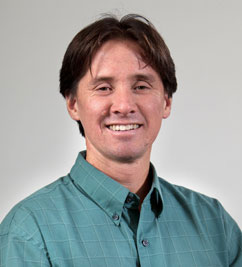Faculty Beliefs about Teaching Found to Change According to Situation
July 1, 2015

Matthew Hora
WCER researcher Matthew Hora finds that faculty often hold multiple beliefs about how students learn best and that these beliefs vary according to the situation.
Hora interviewed 56 science and math faculty at three large public U.S. research institutions with similar numbers of undergraduate students. He concludes that a situative approach most accurately describes how college-level teachers plan and teach their courses.
Three common beliefs
Analysis of faculty interview responses produced 15 beliefs about student learning. Three in particular were commonly reported.
Practice and perseverance. Faculty most commonly reported the belief that students learn best when they study and solve problems on their own time. But evidence suggests that undergraduate study habits have changed. According to one study conducted in 2003, the average full-time student at a four-year college studied 10 hours less per week than four decades earlier.
If that trend holds, Hora says, then faculty expectations for student practice and persistence may not match students’ actual study habits. Many faculty attribute poor outcomes to lack of student effort, rather than to the quality of teaching. The tension between these different causes for poor outcomes—both of which may be true—should be acknowledged by those engaged in instructional improvement.
Variability and learning styles. Several teachers said they believed that learning styles vary from student to student. For example, some students are auditory learners while others learn best through visuals or text, so some teachers differentiate instruction. Although students do have different learning preferences, Hora points to research literature showing that adapting teaching styles to learning preferences makes no statistical difference under controlled conditions.
Hands-on learning. Several respondents reported the belief that learning takes place when students are engaged hands-on with course materials, for example, in laboratories or field work sites.
Teacher-centered or student-centered?
Do students learn best in a “teacher-centered” or a “learner-centered” classroom? The teacher-centered belief asserts that learning takes place largely through students’ internalization of knowledge the teacher presents. The student-centered belief holds that the student is the meaning-maker and creator of knowledge: Students make discoveries on their own, engage in problem solving and critical thinking and benefit from hands-on projects. Instead of an either-or dichotomy, Hora found that individual faculty drew upon both beliefs about teaching, depending on the task at hand.
Implications for policy and practice
Given these complex findings, Hora recommends that policymakers and professional developers account for these factors when designing new curricula, workshops and policies meant to improve teaching in college level classrooms.
This research does not support the view that faculty development programs should encourage faculty to adopt one belief about instructional improvement. Rather, faculty developers should adopt a more comprehensive view of faculty decision-making that allows for more nuance and diversity of belief systems.
For example, too much emphasis on a student-centered belief in learning may unintentionally cause resentment among faculty members who feel their experiences and perspectives are ignored, prompting them to resist educational improvement initiatives.
Conversely, Hora suggests, those advocating policy and reform efforts rooted in a faculty-centered belief for achieving student outcomes should alter their approach and acknowledge the role of students’ study habits in determining their own success or failure.


